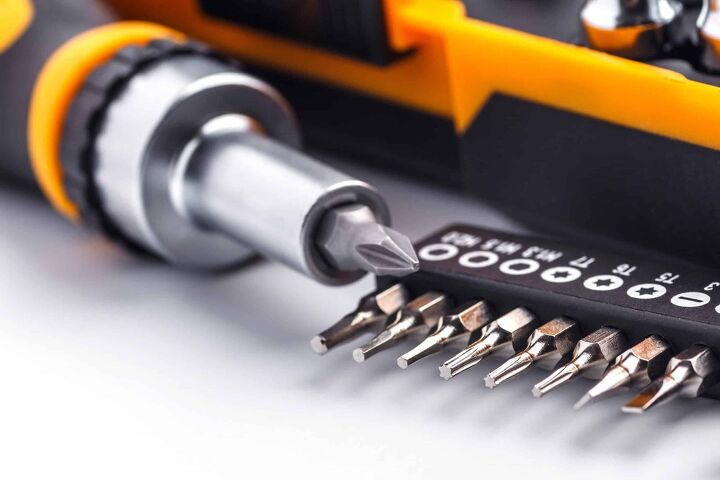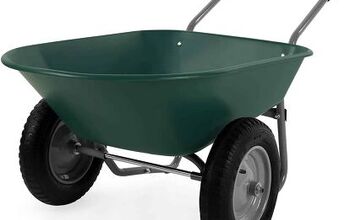25 Different Types of Screwdrivers (and Their Uses)

If you were to ask any DIYer or experienced carpenter what tool takes up the most space in their tool chest, it’s highly likely that their answer will be screwdrivers. Since there isn’t a universal screw that is appropriate for woodworking, decking, framing, or other home improvement projects, it’s crucial to own a variety of screwdrivers and bits for driving or removing any type of screw you may come across.
Most people are aware of at least two types of screwdrivers, however, there are actually a wide array of options to choose from. Whether it’s the common Phillips with its crosshead or the less common Robertson square head screwdriver, each shape serves a distinct purpose. On top of that, you may find yourself needing both manual and powered screwdrivers for various woodworking and home maintenance projects.
The most common types of screwdrivers include flatheads, Phillips, and Torx. Nut drivers are not as common and are used in mechanical fields. To make the job easier, use electric screwdrivers. These range from battery-operated to corded, and even cordless. There are more than 20 types of different screwdrivers out there. Let’s take a look at them together.
Different Types of Screwdrivers
Most of us are aware of a couple of different types of screwdrivers but, in reality, there are numerous options. While there are plenty of screw head type variations for the most common shapes (hex, slot, cruciform, and Torx), there are even more that you’ve likely never heard of in your life.
Let’s explore some of the most common types of screwdrivers that you’ll likely need for tasks around the house, and also those less common drivers that take on a more specialized role.
1. Flat/Slotted Screwdriver
One of the most common types of screwdrivers and likely one you are very familiar with; these screwdrivers feature a chisel-like blade that spans the entire width of the screw’s head. Oftentimes, they double as a chisel in emergency situations and may also be utilized on a Phillips head screw. Though flat head screws aren’t used as greatly in residential construction anymore, you’ll still see them in small cabinetmaking projects, furniture construction, and even some electrical applications.
Flathead screwdrivers are also excellent for prying off the lids of paint cans. You’ll also need this tool for installing plate covers over your switches and outlets. However, slotted screwdrivers are known for being less likely to round a slot than their Phillips counterparts and the tip tends to slip out sometimes when a significant amount of pressure is applied. This is why these screwdrivers are not as popular among professionals as they used to be.
2. Phillips Screwdriver
Nowadays, just about every application requires a Phillips head screwdriver – from appliances to furniture. Phillips screws are easily identifiable by their flared plus sign on their heads and are widely used in woodworking and construction projects. The angled tip of the screw allows you to position a screwdriver deeper into the head, significantly reducing the risk of the blade sliding out sideways.
Phillips screwdrivers are also designed to “cam out,” meaning they will slip out of the head once a certain torque limit is reached. This fact can be considered both a weakness and a strength.
Although Phillips screwdrivers may not ever completely replace flat head screwdrivers, they tend to be the most preferred head and type of screwdriver combo out there. When purchasing a screwdriver set, it’ll almost always feature multiple Phillips screwdrivers.
3. Hex Screwdriver
Other common names for the hex screwdriver include Allen wrench, hexagon, hex key, and security hex version. This is a slightly unusual type of screwdriver that has become increasingly popular in recent years. In most cases, the hex key driver lacks a tip or a handle. They appear like a small, six-sided metal shank in an L-shape and no head. You’ll often see hex keys included with packaged furniture, especially those purchased from places like Ikea.
Allen wrenches are very commonly used for bike maintenance but have grown in popularity among furniture companies and also some appliance manufacturers. The specialized security hex key version is used in high-risk applications, like prison maintenance. The hex screwdriver, on the other hand, functions the same as all the other variations but includes a comfortable handle and a longer shank.
Screwdrivers and bits that fit hex-head screws range in size from around 0.01” to 3/8”.
4. Torx Screwdriver
Originally used for a variety of security applications, Torx screwdrivers have since become popular in commercial industries. The blade of this type of screwdriver appears like a flower or a rounded star, which offers incredibly high torque tolerances. Due to its appearance, you might actually hear Torx screws being referred to as “star screws.”
Currently, you’ll find Torx screwdrivers being used most in security fields and appliance manufacturing because of their efficiency. They are also popular because consumers tend to have a much more difficult time disassembling appliances that are assembled using Torx screws.
5. Roberston Screwdriver
The least common of the most common types of screwdrivers, the Robertson screwdriver tends to collect dust at the bottom of toolboxes. Though, it does offer a distinct advantage or reduced slippage – more so than Phillips screwdrivers. Also referred to as the “square recess screw,” this square-shaped screw head was created in the early 1900s by an inventor in Canada who wanted a solution for slotted screws becoming damaged each time the screwdriver slipped free.
Robertson screwdrivers are very popular in Canada and offer, arguable, the highest torque tolerance of all the other screwdrivers on this list. Due to its incredible durability, you’ll often find square head screws being used in furniture and automotive applications. You’ll also typically find Robertson screwdrivers in complete screwdriver sets.
6. Clutch Head Screwdriver
Moving on to the less common types of screwdrivers, the clutch head driver has seen many design changes throughout the years. The slots look similar to a bow-tie, with the older variation having a circular recess in the center. You’ll likely see these screwdrivers being used throughout the automotive field, especially in older GM and recreational vehicles.
Although clutch head screwdrivers will have better torque with the clutch head screws, they are also designed to work with slotted drivers. There is also a security version of this head that allows you to screw in one direction with a flat-head screwdriver but cannot be removed easily. These are found in areas where maintenance is rare, such as prisons and public transit centers.
7. Frearson Screwdriver
At first glance, the Frearson screwdriver looks similar to its Phillips counterpart. It is a variation of the cruciform style, with a tip that comes to a sharp point. Whereas, Phillips screwdrivers have a rounded tip. The angle of the tip on a Frearson is also closer to a 45-degree angle, making it possible to use one Frearson screwdriver on any size Frearson screw head. These drivers are also compatible with many types of Phillips screws.
Also called Reed & Prince, the Frearson screwdriver’s unique shape offers high torque than a Phillips, and the ability to carry just one drive makes it a very popular choice for nautical equipment and other applications where accuracy and a smaller set of tools are a necessity.
8. JIS (Japanese Industrial Standard) Screwdriver
As one of the world leaders in technology, high standards and uniformity are required and often expected. As a result, every major industrial field in Japan follows standards that are established by a special committee. You’ll find JIS screws in most products that come from Japan.
The JIS screwdriver is a cruciform, like Phillips, but is designed to resist camming out. While it is possible to use a Phillips or Frearson driver on these types of screws, you’ll have an increased risk of damaging the head. To tell the difference between JIS screws and other types, you’ll often find a dot or small mark near the slot.
9. Nut Driver
Though not technically a screwdriver, this driver is worth mentioning. If you are a DIYer, it’s likely that you’ll never come across a nut driver. However, they can be incredibly useful in various mechanical fields. Instead of a blade and tip, these drivers feature a socket. As a result, nut drivers function similarly to a socket wrench.
Nut drivers can be very advantageous when it comes to reaching recessed bolts. While socket wrenches have a handle that runs parallel to the surface where the bolt is embedded, the straight handle and shank of the nut driver make it easier to turn bolts with very minimal clearance. They are ideal for low torque applications, though, you’ll want to stick with the standard ratchet and socket combination for all others.
10. Pozidriv Screwdriver
These types of screws were created as an update to the traditional Phillips design. Pozidriv screws are easily identifiable by the four additional lines that radiate out from the center. These screwdrivers feature a blunt tip, with small ribs along the blade between the primary edges. The design helps to improve torque and reduce the risk of the driver camming out during operation.
Although Phillips and Pozidriv are incredibly similar, they are designed differently enough that if you were to substitute one for the other you increase the risk of damaging a screw head. The design of Pozidriv screwdrivers offers less of a risk of camming out, but the process of manufacturing these types of screws takes almost twice as long. As a result, it’s unlikely that we’ll see these screws replace Phillips as an industry-standard any time soon.
11. Spanner Screwdriver
Also known as drilled head, Snake-Eyes, or pig-nose, the Spanner screwdriver is an unusually designed driver that is meant for use with tamper-proof applications. The screws are flat on the head, with two rounded holes on opposite sides. This design makes it nearly impossible to remove the screw without having the appropriate tool.
Because they offer ample security, you’ll typically see these types of screwdrivers being used by maintenance workers in elevators, bus terminals, public restrooms, subways, and the like. The blade of a spanner screwdriver is very unique, featuring two-prong tips that protrude off the end with a small space in the center.
12. Tri-angle Screwdriver
As the name suggests, the Tri-angle screwdriver has a blade shaped like a triangle. It is commonly used in appliances, toys, and electronics. Like spanner, the design of this screwdriver makes it very difficult for people to tamper with safety covers. Using a screw like this offers an extra level of security. However, a hex drive can be used to grip TA screws, which is exactly why Tri-angle screwdrivers aren’t as typical in screwdriver sets.
The tri-point 3, a variation of the TA, features rounded edges to allow it to be less compatible with hex screwdrivers.
13. Tri-point Screwdriver
Sometimes referred to as Y-type, Y-tip, or 3-Prong, the Tri-point screwdriver consists of a three-edged blade, which appears like a Y and is set at equal 120-degree angles. These types of screws are wildly popular in handheld electronics and can be difficult to handle without the proper screwdriver.
You’ll often find Tri-point screws in Nintendo handheld gaming systems, Apple products, and similar devices. However, it’s incredibly rare to see Y-type screws being used in larger electronics or any non-electronic applications.
14. Tri-wing Screwdriver
Slightly similar to the shape of a pinwheel, Tri-wing screw heads feature a triangular socket with three straight “wings” extending out from each edge in a clockwise fashion. These screws were originally created for use in aerospace engineering but are now typically seen in various home electronics. Since the slot on Tri-wing screws is incredibly unique, you’ll need a Tri-wing screwdriver to remove them.
Tri-wing screwdrivers tend to be relatively pricey and are not as widely available as other types. However, the major advantage of these screws is that they can be tightened to incredibly high torque values. There is also a variation of this type of screwdriver that has left-handed threads, although you can use the same driver for either thread direction.
15. Manual Screwdrivers
This is the screwdriver’s most understood variation. Manual screwdrivers feature a thick, comfortable handle and a cylindrical metal shank that ends with the blade of the driver. In some cases, the tip may consist of an interchangeable bit that allows you to swap it out according to the screw head pattern you’re working with.
Since the handle of a manual screwdriver is larger than its tip, it only demands reasonable twisting force to turn a screw. When you use a manual screwdriver, you will have to lift it from the head of the screw after each turn and then reposition it before you continue with the following turn.
16. Ratcheting Screwdrivers
Ratcheting screwdrivers, on the other hand, reduce the need to lift the screwdriver and reposition it after every turn. This helps to significantly reduce time as you’re operating the driver. These drivers feature and ball bearing mechanism inside that allows the user to make many turns of the screw by performing a back-and-forth action with their wrist.
The screwdriver is given its name because it is operated similarly to a conventional ratchet. This ratcheting action can be altered from one direction to the other by simply pressing a button on the screwdriver. That way, the user can both insert and remove screws. Inserting screws with a ratcheting screwdriver is done with a clockwise motion and removing them involves a counterclockwise motion.
17. Yankee Screwdriver
A Yankee screwdriver is a specific type of ratcheting screwdriver that operates using a spring-loaded ratcheting method. Instead of the traditional wrist action that is used to turn the screwdriver, you just position the tip of the Yankee screwdriver in the screw head and push firmly. This pressure in the direction of the screw causes the shank of the screwdriver to turn.
Then, once you release the pressure, the internal tension spring pushes the handle back to the original position. These types of screwdrivers have been available since the late 1800s, and you can still find them at many home improvement centers.
18. Electric Screwdrivers
There are many different types of screwdrivers that operate on an electric basis. Each variation comes with its own unique set of advantages, but the main thing they all have in common is that they allow the user to apply torque without any manual strength needed. Oftentimes, designated power screwdrivers are designed for specific applications, such as a drywall screw gun for hanging drywall.
Frequently referred to as a power screwdriver, automatic screwdriver, or screw gun, these screwdrivers can simplify difficult jobs – especially when you’re dealing with stripped or damaged screw heads.
Battery-OperatedThere are a number of electric screwdrivers that operate off of battery power This allows the tool to be incredibly compact and nearly as easy to take with you as a manual type. Battery-operated screwdrivers only require a few small batteries. Although they aren’t as powerful as other electric screwdrivers, the fact that they take up considerably less space in your tool belt or box makes battery-operated screwdrivers very advantageous.
CordedThese types of electric screwdrivers aren’t very popular since they require being tethered to a power source. However, they carry the advantage of outputting constant power and are incredibly efficient. This can make corded screwdrivers very useful at busy workstations.
CordlessCordless screwdrivers operate off of a rechargeable battery pack, similar to power drills. This allows you to enjoy the perks associated with battery-operated and corded screwdrivers in one complete package. However, there are some disadvantages that come with these models. Particularly, cordless screwdrivers tend to be much bulkier than battery-operated versions and will slowly lose torque as the battery pack loses power.
Therefore, to enjoy the full power of a cordless screwdriver you want to keep the battery pack fully charged at all times, and possibly consider having a spare on hand.
19. Magnetic
Magnetic screwdriver models come with a magnetic tip for holding the screw in place as you work. The magnetic tip allows you to easily place or remove a screw with only one hand. These types of drivers are quickly becoming a popular alternative to the standard version.
In fact, due to the higher efficiency of magnetic drivers, more and more manual models are being sold with the additional magnetic feature by default.
20. Jeweler’s
Also known as watch or eyeglass screwdrivers, jeweler’s screwdrivers are a class of precision models. They are specially designed to work with incredibly tiny screws, such as those found in pocket watches, eyeglasses, and the link. In many cases, jeweler’s screwdriver sets will come with a combination of flat-head and Phillips sizes.
21. Right Angle
As the name suggests, a variety of screwdrivers are specially designed to be turned at right angles. This additional feature allows the user to work in locations where space is limited for fitting a traditional, straight handle. Because of this, right-angle screwdrivers are very popular in the automotive field and similar industries.
22. Computer
Like jeweler’s screwdriver sets, computer, or electrics, sets come with precision-sized drivers in a wide array of blade types. You’ll find both common and uncommon blade types, including Torx and tri-point in a computer screwdriver set. These screwdrivers are also meant to be used with very tiny screws that are used in the construction of computers, cell phones, and other small electronics.
More Related Guides

Jessica considers herself a home improvement and design enthusiast. She grew up surrounded by constant home improvement projects and owes most of what she knows to helping her dad renovate her childhood home. Being a Los Angeles resident, Jessica spends a lot of her time looking for her next DIY project and sharing her love for home design.
More by Jessica Stone












































